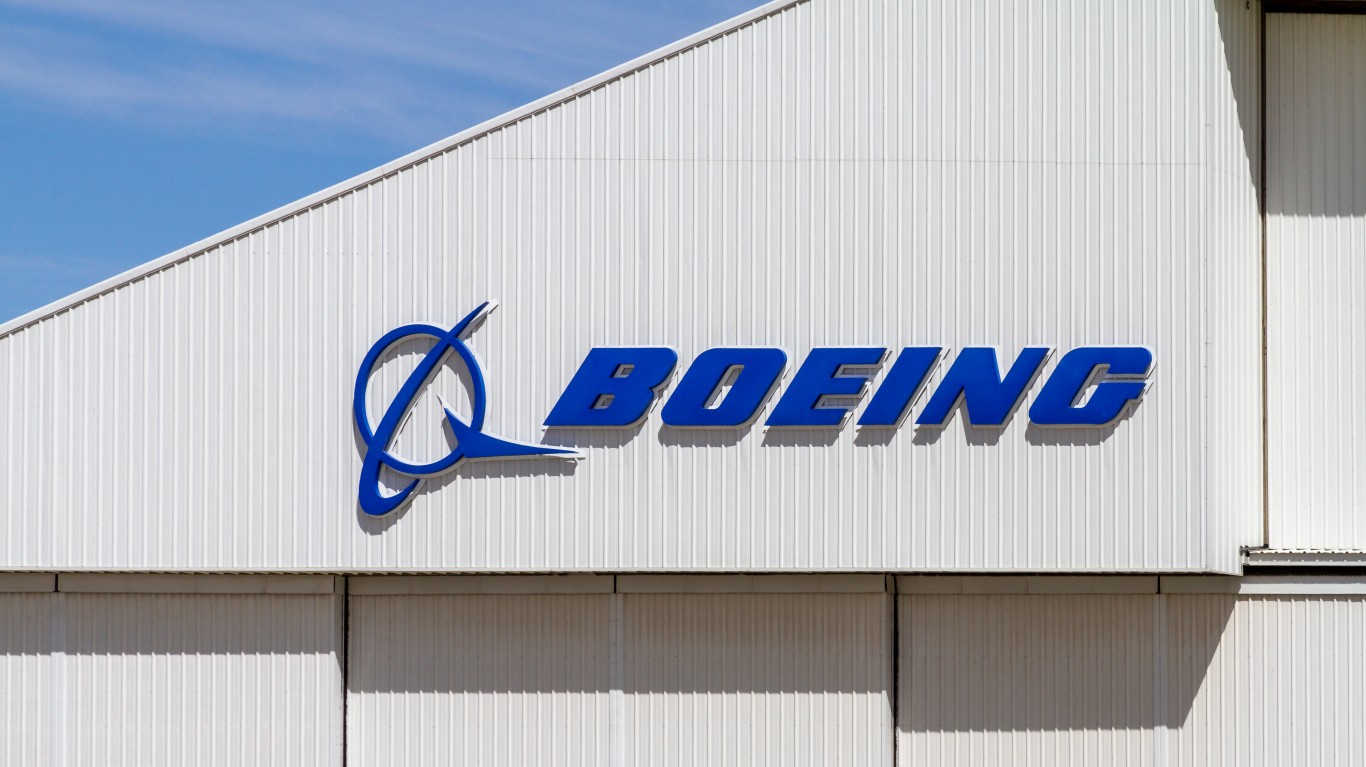
The five largest U.S. traded companies report June-quarter earnings this week, beginning Monday evening with Tesla. We previewed expectations for GE, Raytheon, Tesla, 3M and UPS last Friday and will be covering the others, along with several more, over the next few days.
After markets close Tuesday, Apple, Starbucks and Visa report quarterly results. The estimates for all three include significant increases over the pandemic year. We also have previewed results due Tuesday afternoon from Alphabet, AMD and Microsoft.
[in-text-ad]
Here are previews of four companies reporting earnings before markets open Wednesday.
Boeing
The COVID-19 pandemic added to Boeing Co.’s (NYSE: BA) woes last year. The shares lost about a third of their value during the year but got a boost from the recertification of the 737 Max in November. Over the past 12 months, the stock is up about 28%, but virtually all of that gain came in November, helped along by a second, smaller spike anticipating a pickup in air travel and airline fleet orders.
Shipments of the 787 Dreamliner essentially have been suspended since October, and Boeing is sitting on a finished inventory of around 100 of the planes. There also is some concern that the company would book a forward loss on the 787 program, but such a move would be out of character for Boeing.
Sentiment on the stock is mixed. Of 25 analysts covering the shares that were surveyed, 13 rate the stock a Buy or Strong Buy and 10 rate the shares at Hold. At a recent price of around $223.20, the stock’s implied upside at a median price target of $267.50 is nearly 20%. At the high price target of $314, the upside potential is about 41%.
For the second quarter, analysts are forecasting revenue of $17.04 billion, a sequential increase of 12% and a year-over-year increase of 44%. Adjusted earnings per share (EPS) remain negative, with a loss per share of $0.20 expected, a significant improvement to the first-quarter loss of $0.92 and the year-ago loss of $4.20 per share. For the full year, Boeing is expected to post EPS of $0.55 on sales of $76.72 billion. In 2020, Boeing reported a loss per share of $23.25 on sales of $58.16 billion.
Boeing stock trades at 42.2 times estimated 2022 earnings and 31.0 times estimated 2023 earnings. The stock’s 52-week range is $141.58 to $278.57. The company has suspended its dividend.
McDonald’s
Dow Jones industrial average component McDonald’s Corp. (NYSE: MCD) has posted a share price increase of nearly 26% over the past 12 months. For the year to date, the stock is up about 15%. The pandemic hit the Golden Arches hard, but the business has now recovered to pre-pandemic levels and the year-over-year comparison should be an easy one. Some analysts are looking for a revenue increase above 50% compared with the year-ago quarter.
Most analysts (25 of 35) rate the stock a Buy or Strong Buy and the rest have put a Hold rating on the shares. At a price of around $244.40, the implied upside based on a median price target of $260 is about 6.4%. At the high price target of $283, the upside potential is 15.8%.
Analysts expect McDonald’s to post second-quarter revenue of $5.57 billion, up about 8.8% sequentially and 48% higher year over year. The EPS forecast calls for $2.12, up 10.4% sequentially and 32.3% year over year. The current full-year estimates call for EPS of $8.66 (up 43.2%) and revenue of $22.43 billion, an increase of nearly 17%.
McDonald’s stock trades at 28.2 times expected 2021 EPS, 25.4 times estimated 2022 earnings and 22.9 times estimated 2023 earnings. The stock’s 52-week range is $191.64 to $245.05, and the company pays an annual dividend of $5.16 (yield of 2.12%).
[in-text-ad]
Pfizer
Drugmaker and Dow component Pfizer Inc. (NYSE: Pfizer) saw its shares spike in December following the approval of the COVID-19 vaccine it developed with BioNTech. Since that spike, the stock has traded virtually unchanged through the year to date, after losing the entire gain plus more before rising again after bottoming out in late February.
Recent discussions among health experts point toward a recommendation that people over the age of 50 get a booster shot. What has been holding down the stock price appears to be investors’ concern that the COVID-19 vaccine revenue will come to an end in a few years.
Analysts, by far, rate Pfizer stock a Hold. Of 22 ratings, only five rate the shares a Buy, and none recommend selling shares. At around $41.90 a share, the implied upside to the median price target of $42.20 is less than 1%. At the high target of $53, the upside potential is about 26.5%.
Second-quarter revenue is forecast to come in at $18.73 billion, a jumbo of more than 28% sequentially and nearly 50% year over year. EPS are forecast at $0.98, up about 5% sequentially and about 20% year over year. For the full fiscal year, Wall Street’s current estimates call for EPS of $3.65, up nearly 65%, on sales of $72.05 billion, up 72%.
Pfizer stock trades at 11.5 times expected 2021 EPS and 12.4 times estimated 2022 and 2023 earnings. The stock’s 52-week range is $32.83 to $43.08, and the company pays an annual dividend of $1.56 (yield of 3.74%).
Tilray
Cannabis grower Tilray Inc. (NASDAQ: TLRY) has seen its share price drop by about 15% since completing its acquisition of Aphria in May. The company’s market cap immediately upon closing the deal was around $8 billion. At the current price, Tilray’s market cap is around $6.2 billion.
Even the announcement earlier this month of a Senate bill that would decriminalize marijuana possession and use wasn’t enough to drive the share price up. Tilray does get some love from the r/WallStreetBets crowd and has an average daily trading volume of more than 25 million shares.
Analysts have apparently settled on a Hold rating for the stock. Only three of 13 rate the stock a Buy, while there are no Sell ratings. At a price of around $13.70, the implied upside on a median price target of $17.75 is nearly 30%. At the high price target of $23, the upside potential is about 68%.
For the company’s fiscal fourth quarter, analysts anticipate revenue of $133.61 million, up nearly 11% sequentially and almost 20% year over year. Tilray is expected to post a loss per share of $0.12, better than the first-quarter loss of $0.21 per share. For the fiscal year that ended June 30, Tilray’s loss per share is forecast at $0.51. Full-year sales are forecast to rise by 26%, from $394.59 million to $498.56 million.
Tilray is not expected to post a per-share profit in any of 2021, 2022 and 2023. The stock’s enterprise value-to-sales multiple for 2021 is 12.1 times, dropping to 7.0 times in 2022 and 6.1 times in 2023. Tilray’s 52-week range is $4.41 to $67.00. The company does not pay a dividend.
Cash Back Credit Cards Have Never Been This Good
Credit card companies are at war, handing out free rewards and benefits to win the best customers. A good cash back card can be worth thousands of dollars a year in free money, not to mention other perks like travel, insurance, and access to fancy lounges. See our top picks for the best credit cards today. You won’t want to miss some of these offers.
Flywheel Publishing has partnered with CardRatings for our coverage of credit card products. Flywheel Publishing and CardRatings may receive a commission from card issuers.
Thank you for reading! Have some feedback for us?
Contact the 24/7 Wall St. editorial team.
 24/7 Wall St.
24/7 Wall St.


